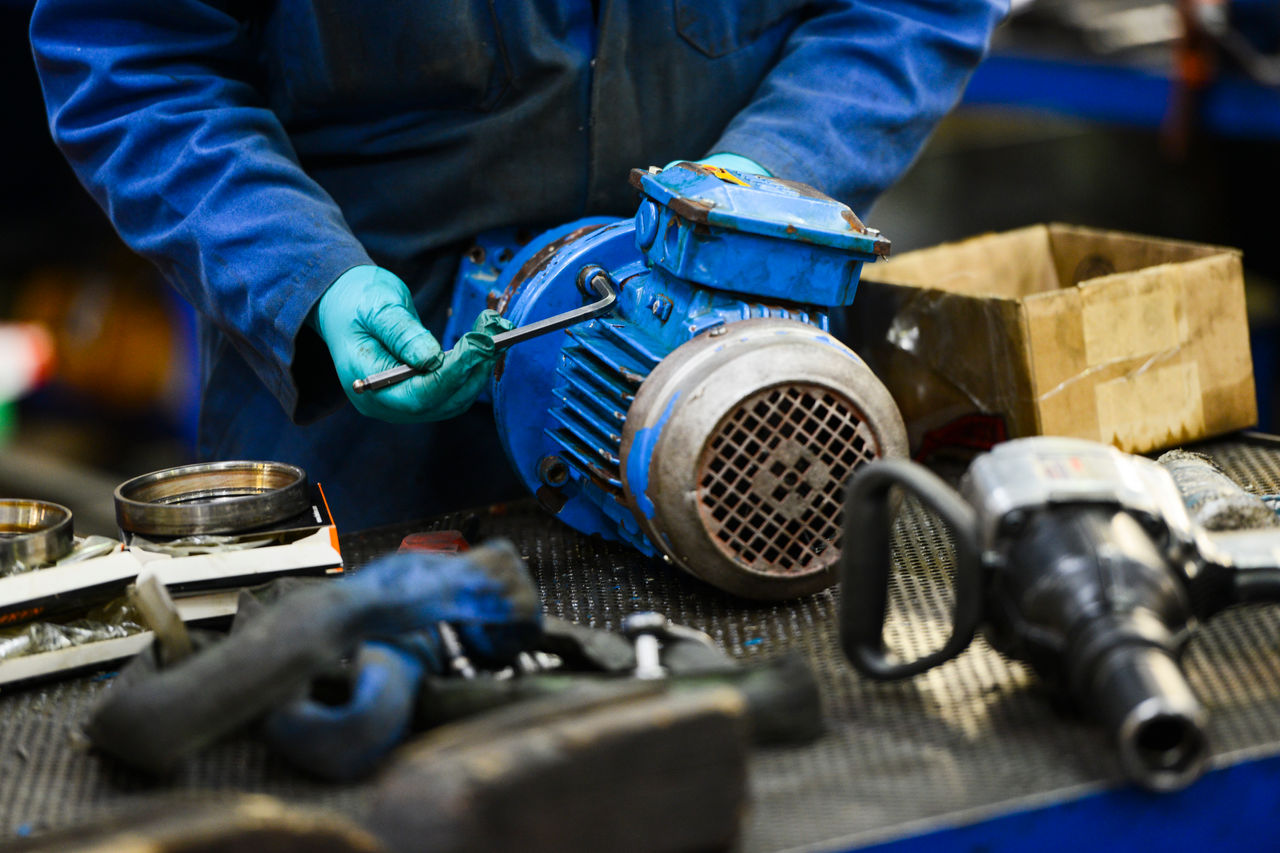In this article
Select the right electric motor in 6 steps
Motors are used in all industries. In fact, everything that moves and turns is propelled by an electric motor. From small, standard motors found in fans, pumps and conveyors to (very) large motors that drive wind turbines, for example. Large motors usually require customisation, as smaller ones are mostly mass-produced and widely used. Selecting the right motor for your application is a meticulous process, in which a wide variety of criteria play a role. We will list the most important steps for you here.

What should you look out for when selecting a motor?
What do you need the motor for? And in what kind of production environment will the motor be used? The answer to these questions will provide initial guidance on what kind of motor is suitable for the specific application. Power requirements, speed and where the motor needs to be installed are other determining factors. What steps should you follow when selecting the appropriate small, standard 3-phase motor for your application?
Step 1 - Determine torque and revolutions per minute
The first step in choosing the right motor involves determining torque and revolutions per minute. You need this to calculate the desired power. That’s because the motor inside an application needs a certain torque and speed to cause a turning moment. Therefore, the questions you should initially be asking are: what do I need to move, how fast do I need to move it and how heavy is it? To further specify the function of the motor, it is also useful to know whether the motor is just intended to run something, provide constant speed or put something in place. The more accurately you can determine the function of a particular motor, the better the choice of motor type will be. After all, some motors are more suited to a particular function than others.
Step 2 - Analysing the production environment
The next important step in the selection process is to analyse the production environment in which the motor will need to operate. Will the motor be used in a laboratory environment where nothing much happens, or will it be running in a setting where it is exposed to one or more production factors? Choosing the right engine depends on, among other things:
- Temperature - At low temperatures, for example, you need specific bearings or a heating element when the motor is stationary.
- Medium - Will the motor come into contact with water/moisture or other liquids? If so, could these fluids affect the drive? In that case, a coating will need to be applied and the motor sealed in some way. This will also affect the choice of the motor type.
- Food safety - Some of the materials used in the construction of the motor may not be food-safe. If so, we recommend not using such motors in the food industry, especially when motor parts come into contact with food.
- Environmental factors - Is the production environment really appropriate for a particular motor? Brushed motors, for example, are unable to cope with polluted environments or those containing aggressive gases. These brushes also create sparks, so they shouldn’t be used in environments with flammable substances. You also have to factor in EMC, electromagnetic interference and radiation. In that case, you'd be better off opting for a brushless motor.
Step 3 - Determine the building form/installation space
The next step is determining the installation space for the motor. In some production environments, this space can be quite limited. An example might be AGV systems (Automated Guided Vehicles). Although these should all be able to lift pallets, the space underneath is very limited. In principle, some motors have a higher power density than others. And one type of motor might also be more compact and deliver more power with the same design than another. If space is indeed a challenge, you could look into applying separate parts of a motor, such as a rotor or stator, separately. The benefit of an electric motor is that it comes in different designs and can therefore be mounted in several ways:
- B3: Mounting using a base - the motor is flat on the ground, with the shaft horizontal and attached to the base.
- B5: Mounting using an outer flange with a diameter larger than that of the motor housing. Flanged motors sit on a pump, for example, with the motor shaft then going directly into the pump.
- B14: Mounting by means of an inner flange with a diameter smaller than that of the motor housing.
- B35: Mounting using a base + outer flange (combination of B3 and B5)
- B34: Mounting using a base + inner flange (combination of B3 and B14)
The design (or mounting method) is indicated by a European IEC34-7 standard code. This standard defines the dimensions of a motor. These include shaft diameter, shaft length, shaft height and bore spacing. This is particularly valid for standard induction motors. Other engines either follow no or a different standard (NEMA). So, if you have a standard induction motor that meets the IEC34 standard, you should select from electric motor suppliers that are able to supply these IEC34 standard motors.
Step 4 - Determine the frequency of movement in relation to lifespan
The frequency of movement produced by the motor largely determines its lifespan. Are we talking about an application that needs to go back and forth once a day, or is it something that runs 24/7? An example might be brush motors. Although these contain brushes for transferring energy, they wear out as they are used more often. Brush motors are nevertheless a great solution for something that needs to move back and forth occasionally, as the brushes will last between 3,000 and 5,000 hours. They are obviously less suitable for applications that run continuously.
Step 5 - Determine the efficiency class
A motor converts electrical energy into mechanical energy. The efficiency between electrical energy and mechanical energy represents the efficiency of a motor. For example, car engines have very poor efficiency. You have to put a lot of energy into them to get back a certain amount of mechanical energy. Efficiency classes range from IE1 to IE4, with the highest number representing the most efficiency.
Applications involving the integration of a new motor may no longer use motors with efficiency classes IE1 and IE2. And from 2025, you will only be allowed to buy IE4 motors. Although these engines are more expensive, the extra costs associated with them are recouped in two years at most, and from then on you can start saving on costs. Companies don’t often see this investment in the short term; however, they usually take action when the current motor needs to be replaced, at which point they see that it can also save them money in the long run.
Step 6 - Controlling the motor
Steps 1 to 5 deal with the characteristics of the motor itself. But how should you control the motor? What kind of interface should the motor have with your system? If you have a system with a controller, and you want to be able to turn it on/off based on a particular output, or you want to have the option of checking the various statuses, so that you can continuously monitor the performance of the motor, the options in these situations are quite wide. There is plenty of choice between different manufacturers, where some have the option of hooking up to an existing system while others don’t. Here, customisation plays a major role.
In this context, the power system also comes into play. What kind of power system do I have? Can the motor be connected to the mains (AC)? Or is it a battery-powered system? If so, this will entail different demands being placed on the motor. A major trend these days involves controls being increasingly integrated into the engine. The benefit of this is that the whole unit is coordinated and compact. As such, the user doesn’t need to buy a separate control box with cables, which reduces the risk of malfunction.
Selection is about more than just the motor
So far, we have mostly talked about the motor and controls. But that's not all. Most motors have high rotational speed and low torque. As far as most systems are concerned, you want the opposite: high torque and low rpm. Similar to your bike and car, there’s a gear somewhere in between, and this usually comes with the motor. The same goes for the reduction gear, where you again have the same choices. Depending on the application, you should also assess which one is most suitable for it. Lifespan and noise are important in this respect. You can also expand the scope of your search by including the drive in the selection process; after all, even if the motor lasts for years, it won’t be of much use to you if the drive unit breaks down within a year. Selection is certainly important in this respect too; with drive technology often coming without maintenance, it simply has to last for a number of years.
ERIKS will help you find the right electric motor
ERIKS represents a number of major electric motor manufacturers. As a result, our range consists of motors that meet current standards and have the necessary quality so that they can be used in any production environment. We make calculations and specialise in programming drive systems so that we can provide our customers with the best possible advice when it comes to choosing a motor that best suits their application. We also create and manufacture completely engineered solutions ourselves. By getting us involved early on in the selection or design process, we will be able to develop solutions with you that lead to cost savings and more efficient production.
Want to know more about how to choose the best electric motor for your application and how ERIKS can assist you in doing so? Contact us - we are happy to tell you more.
Subscribe to our newsletter:
For the latest industry news and updates.
